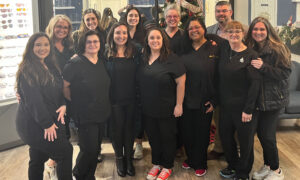By Dave Anderson, OD

May 30, 2018
Whether you have organized weekly, or monthly, staff meetings, or daily huddles, meeting regularly with staff is important to your practice’s profitability and growth. The meetings keep everyone working toward the same goals, and give you an ongoing agenda for what needs to be improved or maximized.
Do It Regularly & Frequently
We have meetings every week in some capacity. Typically we have a staff-wide meeting 2-3 times a month with other meetings with specific departments during the other weeks.
For example, I may be teaching some employees about the various tests that could be ordered for our OCT, how to capture the best images, and what to say to a patient during and after tests. At the same time, my billing manager may be speaking with our optical staff about billing issues for some vision plans, and my partner may be speaking to contact lens staff about how to properly document a specialty lens fitting for keratoconus.
We choose meetings with all staff 2-3 times a month to ensure they don’t become a session for complaints, or an unproductive time. We do them during a time our office is closed, and we found first thing in the morning is best, so we have no interruptions.
Organize Meetings By Department, Too
The smaller meetings are typically done once a month with each department. The challenge here is some overlap of staff in multiple departments. There are some occasions that multiple meetings per month are necessary for a specific department if there are significant changes being made, but usually monthly is the right amount of meetings for each area to ensure everyone is focused on the right way.
Be Methodical in Planning the Meetings
I prepare for the larger meetings by having a discussion with my partner and office manager to lay out the specific topics we need covered. We go over who will cover them, what should be discussed and what should not. We then put together an agenda that is given to all the staff at the start of the meeting. We always leave room for additional concerns and discussions, but we work hard to stick to the agenda. Areas that require a lot of discussion, or that may not have an immediate answer, are tabled for a later meeting.
These meetings are conducted in one-of-four types. At the beginning of the month, we praise our staff for the work done in the previous month, and if we reached the last month’s financial-performance goals, we go over the staff’s incentive payout. We also recognize our employee of the month, and read to all staff the “winning moments” that staff member had during the month, as recognized by their co-workers.
The second type of meeting is informational, usually led by a doctor or a team leader. An example of this type of meeting would be our HIPAA and privacy meeting, or a meeting discussing new technology being added to the office. A third meeting type is when a vendor representative discusses in detail their products, and how they can help our patients.
Finally, the forth meeting type is used to discuss issues that are happening in our practice. We give the staff an opportunity to discuss the issues, but require them to have some solutions, and a possible time line, that could be used to implement change.
Ask Support Staff to Help Prepare for Meetings
Typically we have our team leaders prepare items to be discussed during the meeting. Most of the time, they are consulting with others in their department for input, but the leaders are the ones who would have the floor during the meeting. They occasionally will have someone in the department bring up the specific issue, or provide further detail, but the team leaders are the ones who prepare information for the meeting.
During informational meetings, the biggest challenge is keeping everyone engaged. I have found that there are many ways to do this. The best two that I have implemented is either asking specific questions of the staff during the meeting, or making it more entertaining.
During our HIPAA and privacy meeting I often will play some silly YouTube videos that show how not to protect a patients’ privacy. During meetings to discuss eye health, and what happens in the exam room, I will ask questions of specific staff about what they think a patient’s diagnosis would be, what questions should be asked of the patient, or what the staff member thinks the patient’s symptoms might be given their diagnosis. This keeps everyone interested in the topic, and keeps them engaged.
Take Time to Recap Accomplishments
We always use the first meeting of the month to recap accomplishments. We always point out where we were relative to our goals in the previous month, but we also use this meeting as an opportunity to read patient reviews that were left on online review sites. This helps us respond to bad reviews, to prevent the problems from occurring again, but also to provide praise to the people, and departments, that did a great job.
Be Specific in Goal-Setting
Every time we look to make changes, or set goals, we use staff meetings to do so. One lesson I learned many years ago is that goals are related to a change in the way my staff operates on a given day. A better way of saying this: Staff often perceive a change in their routine as more work without greater compensation. So, the best way to present changes or goals is to lay out the challenges, and provide either an overall goal, or perhaps two choices for the staff to focus on. The concept is to have staff control the change, which makes staff buy-in a natural process, and not something forced from above.
A few years ago we presented the challenge of decreasing vision-care reimbursement. We discussed as a group our two options: Get rid of an insurance plan and eliminate staff, or, two, increase the revenue for each managed care encounter. Our staff obviously chose number two, which was what I hoped they would choose.
We then worked on moving our product categories up, and increasing our AR sales, and decreasing our standard lens product sales. We laid out the goals together, as well as the incentives to help provide continued focus on this area. To this day, we continue to track these metrics, and our staff continues to understand the need to do this.
Include Fun
Finding ways to make learning fun can keep employees engaged. A few weeks ago, we had an informal quiz during a meeting, with the winner of the test awarded a $20 iTunes gift card. We used words from all areas of patient care, so everyone had a good chance. I also discussed each word, or term, while going over the results. Some test questions were: How do you spell lagopthalmus? What does ABN stand for? How do you spell polycarbonate? And what does BAK stand for? This engaged all staff, and allowed me to share information about items each department encounters.
 Dave Anderson, OD, is a partner with Miamisburg Vision Care in Miamisburg, Ohio. To contact: doca@burgvision.com
Dave Anderson, OD, is a partner with Miamisburg Vision Care in Miamisburg, Ohio. To contact: doca@burgvision.com

























